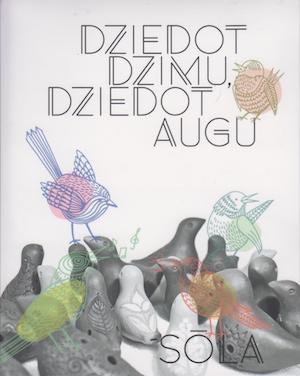One of the most notable events in recent years in Latvian folk music has been the debut of the ensemble Tautumeitas. As their name implies, the group gathers together six ‘folk girls’ who perform songs inspired by Latvian folk songs and folklore. Their first recording, Lai māsiņa rotājās!, was performed together with the drum and bagpipe ensemble Auļi, and the group’s proper first debut album, simply entitled Tautumeitas, was released in 2018.
In just a few years, the ensemble has become one of the best known and most popular folk ensembles, and have even appeared in a commercial for the Latvian national airline airBaltic. The members of the group are Asnate Rancāne (violin, voice), Aurēlija Rancāne (drums, voice), Ilona Dzērve (accordion, voice), Lauma Bērza (violin, voice), Laura Liepiņa (percussion, voice) and Laura Marta Arāja (percussion, voice). The album also features additional musicians and instruments, such as brass instruments and cello. Integral to the album’s sound is also producer, percussionist and arranger Reinis Sējāns.
Though they use many elements from Latvian folklore in their songs, it is still a thoroughly modern album, and one might consider the songs to be a kind of ethno-pop style of world music.
As all six members of the group are singers, it is then no surprise that the vocals are the main focus for the musical offerings. The importance of singing is echoed in the first song, the appropriately titled ‘Sadziedami’, where the powerful vocals are supported by a thunderous musical accompaniment while the ensemble sings ‘sadziedam mēs, māsiņas’ (let’s sing together, sisters!)
Inspired by the Krustabas ritual (or Latvian folk Christening), the song ‘Pāde’ is a song about self-growth. The ritual of the ‘pādes dīdīšana’, where the one being christened is passed around in the arms of the invited guests, is meant to pass along positive thoughts from the guests. In this song, as with many of their songs, Tautumeitas use the mystical aspects of Latvian folk rituals to create a richly layered song, with help from Reinis Sējāns, who provided the arrangement.
Though much of the album is energetic and exuberant, there are moments of calm and tenderness, such as in the song ‘Pelīte’, a soothing, entrancing lullaby. The song tells of a mystical mouse that brings sleep to small children, and shows that the ensemble are equally versatile in both more active songs, as well as calmer and more peaceful songs like this one. Similarly, the somber ‘Raudi raudi’, a song about a boy crying, as the maiden will not come to him, is one of the album’s more intimate moments.
Other highlights include the rhythmic ‘Aiz azara’, sung in the Latgallian dialect, the catchy and infectious ‘Dai citas meitas’, and the mystical, almost ritualistic ‘Raganu nakts’, a vibrant song about witches travelling the land during Midsummer.
Vibrant and vivacious, Tautumeitas’ debut album is both enjoyable and refreshing. With their powerful voices and harmonies, the group has established themselves as one of the premiere ensembles in Latvia. Combining elements of Latvian folklore with modern elements, the ensemble has woven together an engaging collection of songs.
For more information, please visit the Tautumeitas website.
Tautumeitas
Tautumeitas
ONAIR Studios
2018
Track listing
- Intro
- Sadziedami
- Pāde
- Raganu nakts
- Vainagu deja
- Bērziņš
- Pelīte
- Raudi raudi
- Sastdine
- Ūgas
- Bārainīte
- Aiz azzaru
- Dai citas meitas




